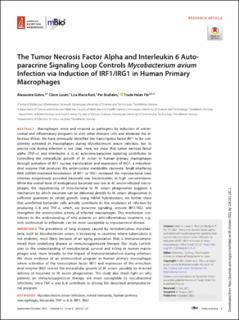| dc.description.abstract | Macrophages sense and respond to pathogens by induction of antimicrobial and inflammatory programs to alert other immune cells and eliminate the infectious threat. We have previously identified the transcription factor IRF1 to be consistently activated in macrophages during Mycobacterium avium infection, but its precise role during infection is not clear. Here, we show that tumor necrosis factor alpha (TNF-α) and interleukin 6 (IL-6) autocrine/paracrine signaling contributes to controlling the intracellular growth of M. avium in human primary macrophages through activation of IRF1 nuclear translocation and expression of IRG1, a mitochondrial enzyme that produces the antimicrobial metabolite itaconate. Small interfering RNA (siRNA)-mediated knockdown of IRF1 or IRG1 increased the mycobacterial load, whereas exogenously provided itaconate was bacteriostatic at high concentrations. While the overall level of endogenous itaconate was low in M. avium-infected macrophages, the repositioning of mitochondria to M. avium phagosomes suggests a mechanism by which itaconate can be delivered directly to M. avium phagosomes in sufficient quantities to inhibit growth. Using mRNA hybridization, we further show that uninfected bystander cells actively contribute to the resolution of infection by producing IL-6 and TNF-α, which, via paracrine signaling, activate IRF1/IRG1 and strengthen the antimicrobial activity of infected macrophages. This mechanism contributes to the understanding of why patients on anti-inflammatory treatment, e.g., with tocilizumab or infliximab, can be more susceptible to mycobacterial disease. | en_US |

